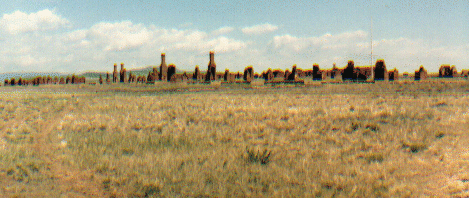
In Santa Fe, Union troops under the command of Maj J.L. Donaldson retreated to Fort Union after torching supply warehouses and cutting down the flag pole so the Confederates would not be able to raise their flag on it.
General H.H. Sibley's forces proceeded to Santa Fe and formally occupied the town on March 13, 1862, by hoisting the Stars and Bars over the governor's palace. Sibley promised "absolute amnesty to all citizens who have, or may within ten days lay aside their arms and return to their homes and avocations."
On 26 March, the Union forces, reinforced by volunteers from Colorado and New Mexico, met Gen Sibley's Confederates at Apache Canyon. After three hours of fighting, the two forces met under a flag of truce, and agreed to delay further fighting until the following morning at eight o'clock. This would give both sides time to bury their dead and tend their wounded.
Fighting resumed at shortly after ten-thirty on the morning of March 27. Alexander Valle stated, "Ze foight six hour by my vatch, and my vatch was slow!"
While the Confederates won on the battlefield, Maj John Chivington, of Colorado, and Lt Col Manuel Chavez, of New Mexico, destroyed the Confederate supply train at the Confederate headquarters at the Johnson's Ranch. Exploding ammunition wounded one man, but the Confederate supplies were gone.
The next morning when the Federals finished burying their dead, their picks and shovels were loaned to the Confederates as their supplies had been destroyed. The morning was spent burying the dead and tending the wounded.
With no supplies, Gen Sibley retreated south and no more Confederate attempts to occupy New Mexico were made. The battles of Apache Canyon and Glorieta Pass have been called the "Gettysburg of the West."
In 1987, a grave containing thirty-one bodies dressed in Confederate uniforms was accidentally unearthed. While operating a backhoe to lay a foundation for his home, the owner of an adjacent property accidentally unearthed the long-sought cemetery.
Personal observation and the writings of Marc Simmons and Roadside History of NEW MEXICO, by Francis L. and Roberta B. Fugate, 1989.
This page updated 31 October 1998